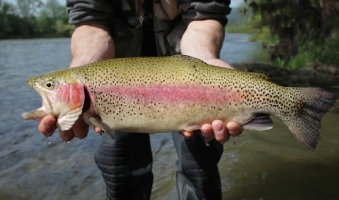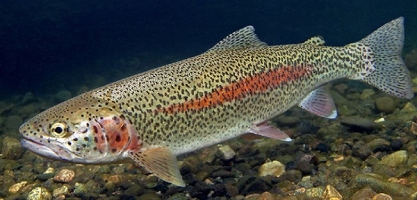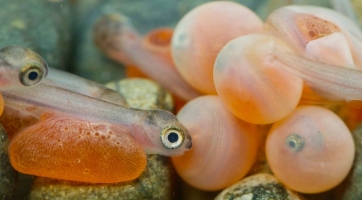The speckled Rainbow trout is a diversely dispersed fish known scientifically as Oncorhynchus mykiss. It calls the cool waters of the northern Pacific its home, from fast-flowing streams to deep alpine lakes across Asia and North America. Within this vast domain thrive different trout types across numerous categories, predominantly the flashes of color found within Oncorhynchus and deep water prowlers under the banner of Salvelinus. The Rainbow trout and chasing salmon make up the lively Oncorhynchus, while the latter also shelters char – trout alike in appearance yet set apart by nature.
Both ecological contributions and economic benefits derived from this rainbow denizen play a role as dynamic as its dazzling dorsal colors in the well-ordered spheres where it resides.
How to Tell Them Apart from Other Fish

Rainbow trout are easily identifiable due to their colourful scales and streamlined body shape, both of which suit them to live in freshwater streams. Their dorsal fin, posterior and upper flank are marked with little coal spots.
Rainbow trout can vary greatly in size. Some can be over a foot long by the time they reach maturity. Others, however, thrived, and their numbers soon swelled. Final records show them reaching well over three feet and more than twenty pounds in prime locations. A rosy or scarlet line courses along the length of the silvery blue or grayish skin. Variable, the sentence structure of human pens: Long and flowing at times, short and crisp at others.
Where Do They Naturally Belong

Rainbow trout thrive in cold, clean water with high oxygen levels. They inhabit various freshwater environments, such as cold-water lakes, oxygen-rich water bodies and reservoirs at elevations where water temperature remains below 60 degrees. While Rainbow trout prefer cold water, they can also tolerate slightly higher temperatures.
They can also be present in clear, fast-flowing rivers, mountains and streams with gravel or rocky bottoms. Rainbow trout love deep pools and shaded areas, which shield them from predators and strong currents.
Their Favorite Meals and How They Catch Them
Rainbow trout wander the waterways, opportunistically scouring the currents for whatever scraps of sustenance drift within reach. Their menu knows no bounds, ever eager to sample any bite that benefits their belly. Chief among their culinary cravings stand mayflies and stoneflies, minnows and minnows, along with shrimp and the tiniest plants that permeate the pools. Yet not solely do they feast on flickers that float the flows; when insects tumble from above, they tune hungrily to terrestrial morsels, making ants and beetles a meal.
Whether hovering near the surface or hunting amid the highways of the riverbed, they arrest the eyes of those eager to ensnare them with feathered follies. Shifting with the seasons, too does their diet – as spring and summer bring banquets of bugs, so autumn and winter wield fish and crustaceans to critical acclaim.
The Amazing Life Cycle of These Fish

Like other trout kinds, Rainbow trout have an intricate reproductive cycle, relying on particular natural circumstances for booming prosperity. The initial stage is the birthing time, which comes about in springtime when water temperatures range from 44-50°F (7-10°C).
This is then adopted by the nest-constructing period, in the course of which females generate superficial nests in gravel beds and put numerous eggs. Males make the eggs fertile, which are then concealed under gravel for protection. The eggs hatch into alevins (larvae with yolk sacs). Even so, they remain covered in the substrate until they evolve into fry.
In photos of small trout, called parr, the juvenile form, they sport characteristic markings before they grow to adulthood. Their mating rituals and nesting require cool, gravel-bottomed waters, much like any other river fish, for as long as they continue to spawn and flourish.
Why People Love Catching and Farming This Species
Rainbow trout are among the most economically and recreationally essential fish species. Due to their fast growth and adaptability, they benefit fisheries and local economies. Rainbow trout are widely farmed for food in North America, Europe, and South America.
Most government agencies fill rivers and lakes with rainbow trout to support recreational fishing industries. Because of their strong fighting ability, rainbow trout are highly prized in sport fishing and present a challenge for anglers.
What’s Hurting Their Population and How to Help
Dam construction, deforestation, urbanization, and water pollution degrade the feeding grounds and freshwater habitats that Rainbow trout rely on. Industrial pollution also introduces dangerous chemicals to water bodies, thereby affecting these aquatic organisms.
Furthermore, the rising climatic temperatures and droughts threaten the cold-water habitats essential for their survival. A warmer aquatic environment increases parasitic and bacterial disease outbreaks in Rainbow trout.
Some of the possible ways to protect rainbow trout include river restoration, dam removal, and pollution reduction. Measures should also be taken to reduce industrial waste and agricultural runoff.

